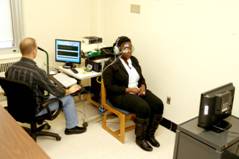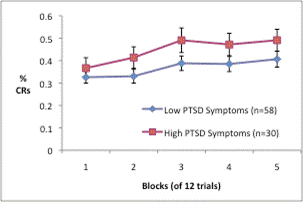Human Learning and Memory
Post-traumatic Stress Disorder (PTSD)
After exposure to a traumatic event such as combat, rape, or natural disaster, most people show characteristic stress reactions including heightened anxiety, sleep disruptions, and avoidance of reminders of the trauma. In most people, these symptoms abate with time, but in 10-15% of people these symptoms persist, leading to PTSD. Given that the majority of people exposed to a trauma do not develop PTSD, there must be pre-existing vulnerability factors that determine an individual’s risk profile for PTSD when that individual is exposed to trauma.
The SMBI is investigating vulnerability to PTSD in terms of a learning-diathesis model. According to this model, certain individuals (by virtue of genes, temperament, prior history, etc.) are predisposed to learn certain kinds of information particularly quickly and strongly; these learning biases mean that, if the individual is involved to extreme stressors – such as wartime deployment and combat in veterans – there is increased risk of PTSD, compared to an individual without these biases who is exposed to the same stressor.
 Consistent with this model, veterans with a high degree of self-reported PTSD symptoms are faster to learn a simple motor response – eyelid closure in response to a tone that predicts an upcoming airpuff to the eye – than veterans with low-to-moderate PTSD symptom severity.
Consistent with this model, veterans with a high degree of self-reported PTSD symptoms are faster to learn a simple motor response – eyelid closure in response to a tone that predicts an upcoming airpuff to the eye – than veterans with low-to-moderate PTSD symptom severity.
As a measure of simple motor learning, we have used delay eyeblink conditioning, in which subjects receive a mildly-aversive puff of air to the eye, which causes a reflexive, protective eyeblink. If the airpuff is reliably preceded by a tone, subjects learn an anticipatory eyeblink to the tone, so that the eye is already partially closed (and partially protected) at the time of anticipated airpuff arrival. The learning-diathesis model of PTSD predicts that such simple stimulus-response learning may be facilitated in individuals vulnerable to the disorder.
In addition, studies in collaboration with Mark Gilbertson and Scott Orr at the VA Medical Center in Manchester, NH, are showing that veterans with current, severe PTSD are impaired at more complex forms of learning that require the hippocampus, such as learning how to generalize between stimuli that have been associated with similar outcomes in the past.


Left: On a simple test of motor learning (eyelid closure in response to a tone that predicts an upcoming airpuff to the eye), veterans with a high degree of self-assessed PTSD symptoms learn slightly faster than veterans with low-to-moderate symptom severity. Right: On a test of more complex hippocampal-dependent learning, veterans with a current diagnosis of PTSD are impaired relative to veterans with no history of PTSD. Together, these results suggest that PTSD may be associated with facilitated learning of simple responses but impaired learning of more complex, hippocampal-dependent information.
Together, these studies suggest that learning biases – such as strong, fast learning of simple associations paired with a reduced ability to learn more complex, hippocampal-dependent associations – may be an important feature of PTSD vulnerability.
These results are consistent with the idea that faster learning is associated with PTSD risk, although they cannot prove that faster learning causes PTSD risk. For that, prospective studies are needed in which individuals are first assessed for learning biases and then tracked to see if PTSD develops following exposure to trauma. Such studies are planned in collaboration with the Office of Naval Research (ONR) and Navy Bureau of Medicine (BUMED), as well as with colleagues at Rutgers University, NJ, to administer hippocampal-dependent tasks to Marines before deployment. If Marines who show hippocampal-dependent impairments are subsequently more likely to develop PTSD, compared with peers who do not show the impairments, this would greatly strengthen the argument that learning biases pre-date, and may contribute to, PTSD risk.
If the learning-diathesis model of PTSD vulnerability proves accurate, this has important implications for understanding and treating the disorder, by developing therapies that take an individual patient’s learning biases into account.
Representative Publications:
Myers, C. E., VanMeenen, K. et al. (2010). Faster acquisition of eyeblink conditioning by veterans with symptoms of post-traumatic stress disorder. Proceedings of the Annual Meeting of the Society for Neuroscience, San Diego, CA, Nov. 13-17, 2010.
